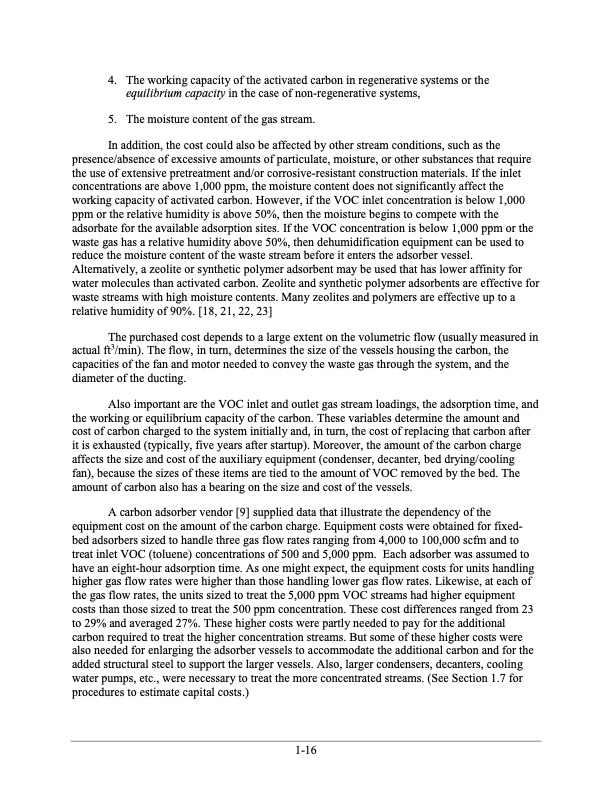
PDF Publication Title:
Text from PDF Page: 020
4. The working capacity of the activated carbon in regenerative systems or the equilibrium capacity in the case of non-regenerative systems, 5. The moisture content of the gas stream. In addition, the cost could also be affected by other stream conditions, such as the presence/absence of excessive amounts of particulate, moisture, or other substances that require the use of extensive pretreatment and/or corrosive-resistant construction materials. If the inlet concentrations are above 1,000 ppm, the moisture content does not significantly affect the working capacity of activated carbon. However, if the VOC inlet concentration is below 1,000 ppm or the relative humidity is above 50%, then the moisture begins to compete with the adsorbate for the available adsorption sites. If the VOC concentration is below 1,000 ppm or the waste gas has a relative humidity above 50%, then dehumidification equipment can be used to reduce the moisture content of the waste stream before it enters the adsorber vessel. Alternatively, a zeolite or synthetic polymer adsorbent may be used that has lower affinity for water molecules than activated carbon. Zeolite and synthetic polymer adsorbents are effective for waste streams with high moisture contents. Many zeolites and polymers are effective up to a relative humidity of 90%. [18, 21, 22, 23] The purchased cost depends to a large extent on the volumetric flow (usually measured in actual ft3/min). The flow, in turn, determines the size of the vessels housing the carbon, the capacities of the fan and motor needed to convey the waste gas through the system, and the diameter of the ducting. Also important are the VOC inlet and outlet gas stream loadings, the adsorption time, and the working or equilibrium capacity of the carbon. These variables determine the amount and cost of carbon charged to the system initially and, in turn, the cost of replacing that carbon after it is exhausted (typically, five years after startup). Moreover, the amount of the carbon charge affects the size and cost of the auxiliary equipment (condenser, decanter, bed drying/cooling fan), because the sizes of these items are tied to the amount of VOC removed by the bed. The amount of carbon also has a bearing on the size and cost of the vessels. A carbon adsorber vendor [9] supplied data that illustrate the dependency of the equipment cost on the amount of the carbon charge. Equipment costs were obtained for fixed- bed adsorbers sized to handle three gas flow rates ranging from 4,000 to 100,000 scfm and to treat inlet VOC (toluene) concentrations of 500 and 5,000 ppm. Each adsorber was assumed to have an eight-hour adsorption time. As one might expect, the equipment costs for units handling higher gas flow rates were higher than those handling lower gas flow rates. Likewise, at each of the gas flow rates, the units sized to treat the 5,000 ppm VOC streams had higher equipment costs than those sized to treat the 500 ppm concentration. These cost differences ranged from 23 to 29% and averaged 27%. These higher costs were partly needed to pay for the additional carbon required to treat the higher concentration streams. But some of these higher costs were also needed for enlarging the adsorber vessels to accommodate the additional carbon and for the added structural steel to support the larger vessels. Also, larger condensers, decanters, cooling water pumps, etc., were necessary to treat the more concentrated streams. (See Section 1.7 for procedures to estimate capital costs.) 1-16PDF Image | Carbon Adsorbers

PDF Search Title:
Carbon AdsorbersOriginal File Name Searched:
final_carbonadsorberschapter_7thedition.pdfDIY PDF Search: Google It | Yahoo | Bing
CO2 Organic Rankine Cycle Experimenter Platform The supercritical CO2 phase change system is both a heat pump and organic rankine cycle which can be used for those purposes and as a supercritical extractor for advanced subcritical and supercritical extraction technology. Uses include producing nanoparticles, precious metal CO2 extraction, lithium battery recycling, and other applications... More Info
Heat Pumps CO2 ORC Heat Pump System Platform More Info
| CONTACT TEL: 608-238-6001 Email: greg@infinityturbine.com | RSS | AMP |